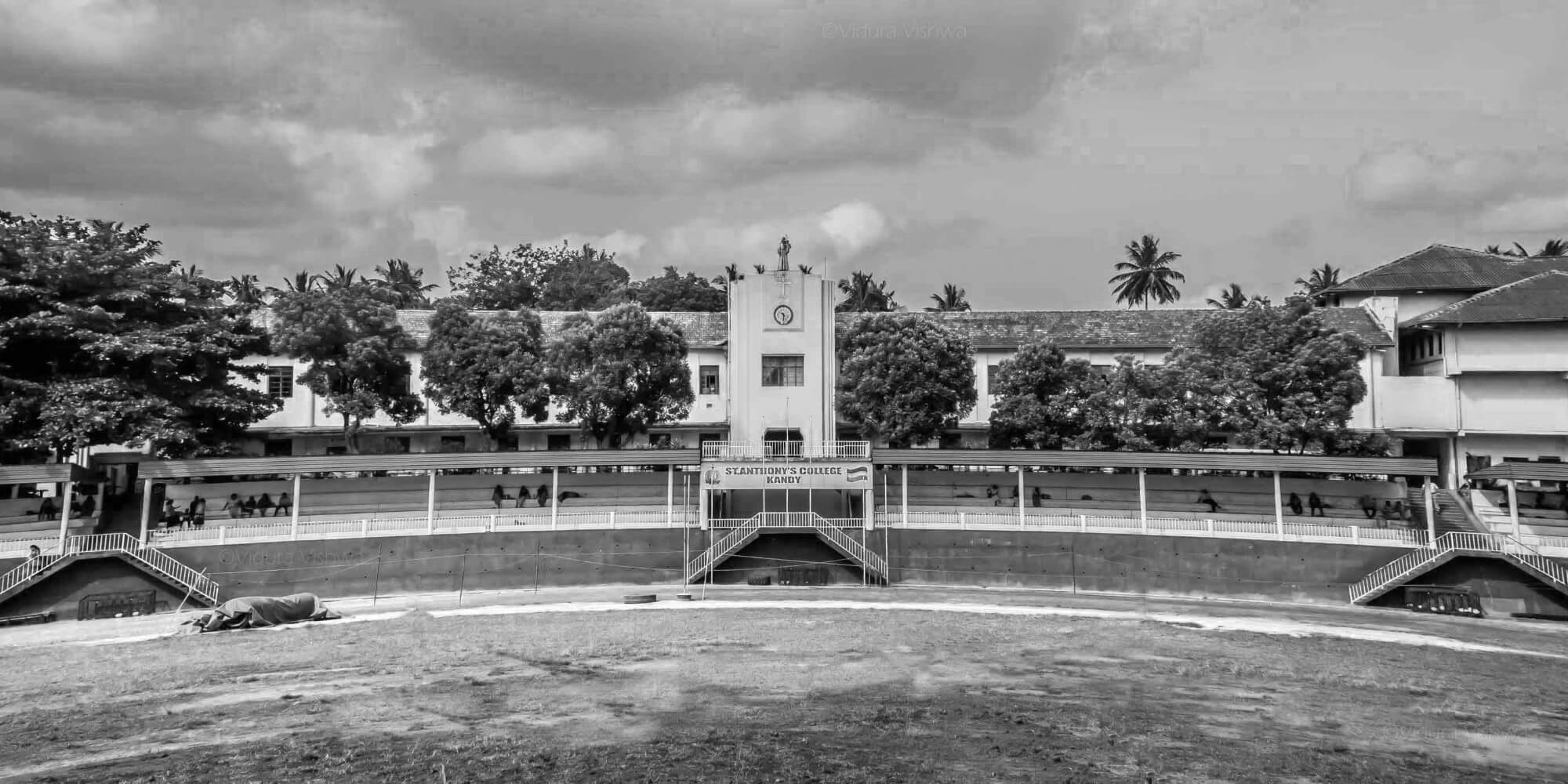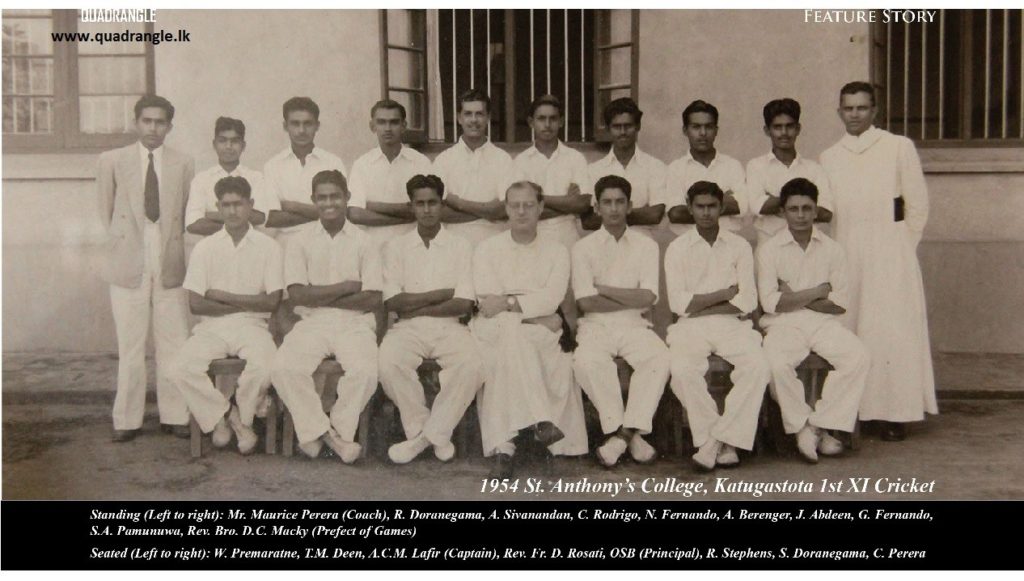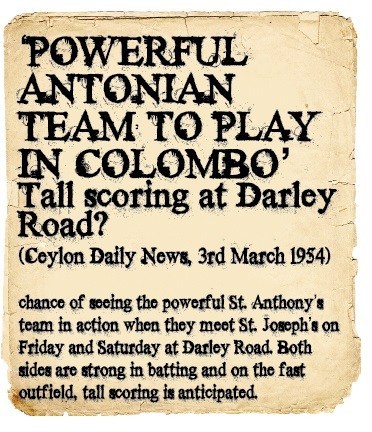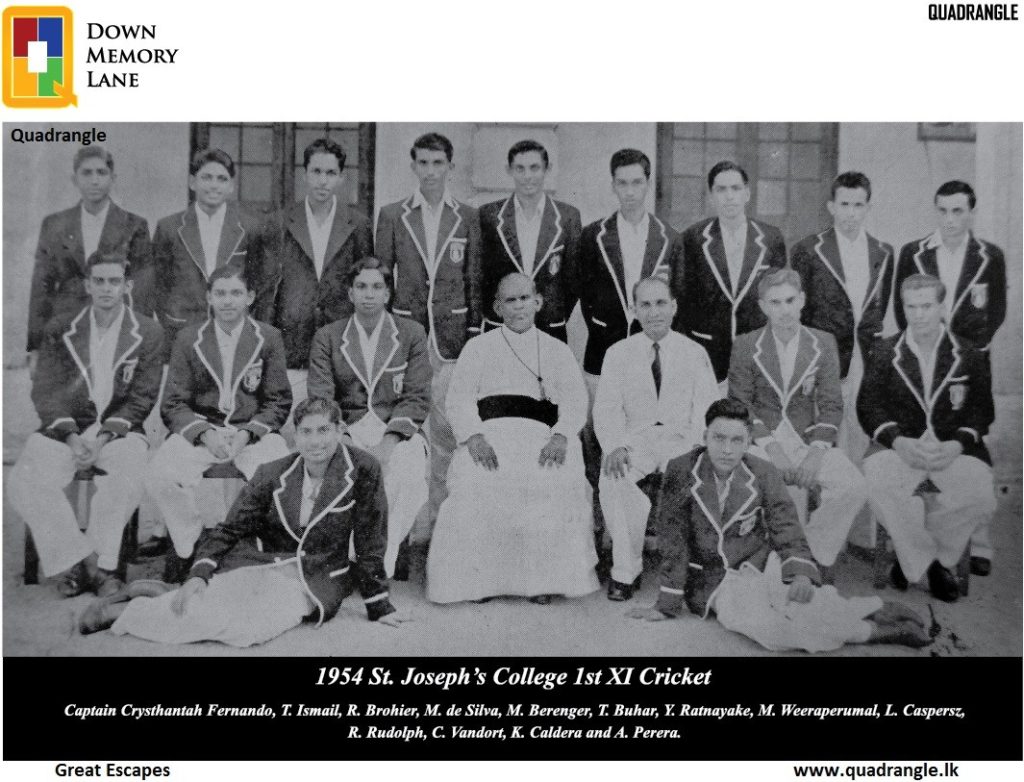Address
SACKOBA HQ,
St. Anthony’s College,
Kandy, Sri Lanka 20000
Email Address
secretary@sackoba.lk
editor@sackoba.lk
Address
SACKOBA HQ,
St. Anthony’s College,
Kandy, Sri Lanka 20000
Email Address
secretary@sackoba.lk
editor@sackoba.lk

It was the early 1960s. I was a primary school student at St Joseph’s College, and my father accompanied me daily to school. During that period, classes began at 9am and ended at 3.30pm. Since my father was a government servant working at the Census and Statistics Department, I had to fall in line with his official commitments and spent more time on the school premises than most other students.
I would arrive in college even before the blue clouds lined the unpolluted Colombo skies and leave the college gates at the threshold of sunset, which certainly added a few extra hours to my regular school day. Hence, I occupied my time by being an altar server at holy mass and a keen spectator of Josephian sportsmen at their practice sessions in the afternoon.
The walk down to the Maradana railway station after school with my father during those late afternoons was a fascinating experience. Although it was a stone’s throw distance from the college to the railway station, we had a regular stoppage at a small saruwath kade near the Olympia Cinema. My father always made it a point to buy me a glass of normal rose-coloured sherbet, although my eye always focused on the numerous multi-coloured saruwath glasses kept on display in the showcase of this roadside cool-drink stall. While I enjoyed my cool drink, my father would buy a copy of the late edition of the Observer or Times and have a quick glance at the last page – the sports page. It was the time when our English dailies carried full coverage of not nly Test cricket matches played by the Englishmen, Aussies and the West Indians, but also their domestic matches, such as Sheffield Shield and county matches.
My father was a keen follower of Australian cricket. On our way to the railway station he talked about his sporting favourites and their deeds. I could vividly recall how excited he was when he painted the vivid picture before me of the tied Test in 1960 between Australia and England. The names of his favourites: Neil Harvey, Norman O’Neill, Alan Davidson, Richie Benaud, Frank Worrell, Rohan Kanhai, Gary Sobers, Wesley Hall, Sonny Ramadhin and Alf Valentine, among others, gushed out of him; but the graphic account always ended with the hero of the match, Joe Solomon, who ran out the last Aussie batsman, Ian Meckiff, with a bullseye throw in the penultimate ball of the match when the scores were tied!
Having being denied participation of any major sporting activity on the playing field at school, I had to rely on my imaginary world of sport to give me the glory which I sought. When my father described the tied Test, I felt like I was there and could imagine every detail as if I had seen it. Sometimes, I would be a spectator; other times a player along with the 22 greats who played and achieved immortality!
From the day I heard about this match, it had a supreme impact in my book-cricket score cards. Although in my book-cricket matches, the same 22 players took part in my replaying the First Test in Brisbane – Australia vs West Indies 1960. I never ever achieved a tied match as I had the habit of opening the pages of my school text book used for my book-cricket with numbers in ‘6 or 4’ while the Aussies were batting and opening the ‘1 & 2s under the names of West Indian batsmen. By then, naturally, my father’s favourite team was turning out to be mine too!
During the train journey from Maradana to Hunupitiya station, I was in my imaginary world of sports, with Neil Harveys, Keith Millers, Davidsons and O’Neills. Once in a way, my dreams turned to Truemans and Stathams!
If it is not on Test cricket, my father would talk about school cricket of his time and his favourites such as Robert Fernando, K. W. Dewanayagam and Hector Perera (Snr) among others. Some days he recounted explosive hitting of schoolboy cricketers and of those great school matches of the past, which he had witnessed.
It was during one such occasion I heard of incredible power-hitting of T. M. Deen of St Anthony’s College, Katugastota. My father was there at his college grounds, in Darley Road, among hundreds of spectators who were kept for 50 minutes or so in utter disbelief in day one of the match. And once again in day two, also for a brief period. My father had a liking for this match and whilst pointing out the landing areas of those mighty sixes hammered by T.M. (Tom) Deen, he casually added that despite their entertaining cricket, the Antonians had a close call at the end and the honours had to be shared. Many a decade later, I had the opportunity of browsing through the full scorecard of this historic match. The scorecard makes one’s hair stand on end as would a Hitchcock thriller.

St Anthony’s College, Katugastota celebrated its centenary in 1954 and was fortunate to have one of the all-time great cricket teams during the season. The team was led by A.C.M. Lafir, who his coach Maurice Perera called “captain courageous”.

When the Katugastota schoolboys travelled down to Colombo for their fourth match for the 1954 season, to confront St Joseph’s College, the local press predicted an exciting match. The college magazine of St. Anthony’s noted: “With an outburst of publicity in the press, we travelled to Colombo to meet St Joseph’s. This encounter was looked forward to with extreme interest by many, some of whom made a special trip for the purpose.”
The match evoked another interesting aspect. Although St Joseph’s had a long list of victories (29 in all till 1954) under its name since the inaugural match between these two schools in 1899, their opponents has recorded only six victories up to 1954. Importantly, the last Antonian victory over the Josephians until then was as far back as 1930, where the hill-country school was victorious by a solitary run!
A brief description of the 1930 SJC vs SAC match played at Bogambara grounds: St. Anthony’s 59 (M. D. Banda 11, five batsmen were out scoring 6 runs each) and 108 (H. Jayasundera 47, K.C. Visvanathan 15.3-6-30-7) beat St. Joseph’s 72 (Romel Rodrigo 13, Robert Fernando 0, K.W. Dewanayagam (Capt) 0, K.C. Visvanathan 29, Noel de Costa 15, Noel Bevan 11) and 94 (Gautamadasa who was not called to bowl in the first innings had the figures of 13-3-28-6. SJC were 32 for 1 at one stage, but collapsed for 46 for 6 and 91 for 7 before being bundled out for 94) by one run.
Deen slammed four sixes and six boundaries in his all too brief knock of 60 runs. Two of his mighty hits landed in the Home for the Aged, one in the Bonjean Hall Tower and the fourth in a boutique on Darley Road.
When the Antonians met the Josephians at Darley Road, on March 5 and 6, predictions were made of a possible Antonian victory. The Antonians piled up massive totals in their previous three matches: 246 against St. Peter’s, 382 in an innings victory against St. Benedict’s and 267 against Ananda. On the other hand, the Josephians had to be content with tame draws against St Benedict’s, Royal and Wesley.

The Josephians took first lease of the matting wicket, with their opening batsmen Y. Ratnayake and C. Vandort facing Tom Deen and Sali Doranegama. The openers did not last long, Vandort was out for 1 (ct. C. Pereira bld. Deen) and Ratnayake for 6 (ct. & bld. Deen). 26 for 4 at one stage, the home team totalled 199. Skipper Chrysantha Fernando (77), R. Brohier (26) and 23 extras were the chief contributors. Tom Deen claimed the figures of 11-1-47-4. K.R. Caldera and T.A. Buhar were his other victims. The Josephian batting line-up also included Talat Ismail, Mahinda de Silva, R. Rudolph, L. Caspersz and M. Berenger.
The visitors began their innings with Ronnie Stephens and skipper A.C.M. Lafir, followed by G. Fernando and W. Premaratne. The match which had gone on until then without creating much excitement, except for Lafir’s elegant knock, suddenly sparked with the arrival of T.M. Deen to the middle.
The Antonians began in cavalier fashion but Lafir’s brilliance was unlikely to last. In his short knock of 32 runs he had seven shots to the ropes. His dismissal took some zest out of the Antonian side and soon they had lost 4 wickets for 124. Then into the arena strode Deen. When he left an hour later the Josephian total had been bypassed. But what hitting was witnessed in the interval. Deen slammed four sixes and six boundaries in his all too brief knock of 60 runs. Two of his mighty hits landed in the Home for the Aged, one in the Bonjean Hall Tower and the fourth in a boutique on Darley Road.
This is how journalist Maxwell Jacotine recalled what happened next in his article in the Sunday Observer in 1969
According to an account (“Cricket Notes 1954 – The matches as Cecil Rodrigo saw them”) appeared in the College magazine of St. Anthony’s: “——Darley Road, the Home for the Aged and the tall Bonjean Tower were the landing places of Deen’s colossal sixers. Both the Josephian pacemen were thrashed for a six each and even, Berenger, the most accurate schoolboy bowler of the year, found a place in the Home for the Aged. Deen’s innings lasted only 55 minutes during which time he kept the spectators on their toes. It was a memorable innings the like of which, according to sports writers in the local press, had not been seen on local cricket grounds since the days of such men as Oswin Wright and Neil Joseph.”
Maurice Perera, the coach of this invincible Antonian team (1954) had this to say about Deen’s classic innings: “T.M. Deen, a dynamic personality, unpredictable like Keith Miller, yet a brilliant all-rounder, struck terror into the hearts of his opponents with both bat and ball. His carefree attitude towards the game enabled those who were fortunate enough to witness it, to see one of the finest bits of hitting ever seen at Darley Road. His sixers soaring to all parts of the ground brought the large crowd to its feet.”
St. Anthony’s had 221 (T.M. Deen 61, S. Doranegama 45) on the board before the Josephians took their second turn at the wicket, little after noon in day two. The Josephians started off on the wrong foot. By the time of the milk interval they were 26 for 6. Interestingly, all six wickets were taken by the Antonian opening bowling pair – Deen and S. Doranegama. Face-saving innings of Mahinda de Silva (ct. G. Fernando bld. Deen 70), R. Rudolph (31) and L. Caspersz (23) lifted the total to 155 thus leaving the Antonians to score 133 in couple of hours of playing time remaining.
With an impressive match record in the previous three outings behind them – “that time saved St Peter’s, the weather saved Ananda” and an innings victory over St Benedict’s where no interference of weather or time – it was almost certain another Antonian victory was on the cards in their centenary year. For the first time over the Josephians after a lapse of 24 years; and for the first time at the Darley Road grounds.
Ronnie Stephens and skipper Lafir started off the run chase steadily and were involved in a 30-run partnership. Stephens scored 23 (bld. M. Berenger) and Lafir 18 (bld. T. Buhar). Thereafter, the same two Josephian pacemen claimed the wickets of W. Premaratne (12) and G. Fernando (01).
And when the batsman who set the ground alight in the 1st innings, T.M. Deen walked to the middle, the scoreboard read 42 for 3. He was once again in his cavalier mood, slamming another couple of towering sixers which saw the ball soaring high and high before landing far away from the grounds. Unfortunately, his extraordinary big hitting came to an end when he was out for 33 (ct. Ratnayake bld. Berenger).
The second highest scorer in the first innings S. Doranegama also had a short stay at the middle before he was clean bowled by Buhar for 12 runs; 86 for 5 at one stage, the Antonians were struggling at 113 for 9 (Ranjit Doranegama 8, J. Abdeen 1 and G. Pamunuwa 1) when wicket-keeper Cuthbert Pereira, who was injured early in the day, was joined by the last man A. Sivananthan.
Cecil Rodrigo’s “Cricket Notes 1954” in the Antonian magazine graphically described the tension-filled last phase of the match. He says: “Deen once againtook the wicket amidst roars of cheers. In his usual style he went out for the runs and top scored with 33 runs which included another two sixers. But after his departure victory left us and went in close reach of St Joseph’s. Our last pair, Sivananthan and Cuthbert Pereira, the latter despite a swollen eye, stuck to their guns for a full 20 minutes. They were neither perturbed by the cheering nor upset by the sting of Buhar who bowled so accurately. This pair put a thrilling end to a game that was doomed to end with a result.”
At the end, the Antonians were 119 for 9 (C. Pereira n.o. 4 and A. Sivananthan n.o. 2, Buhar 4 for 34 and Berenger 4 for 42).
Thus came an exciting end to a great cricketing encounter.
Source: https://quadrangle.lk/magical-moments-time-great-escapes/